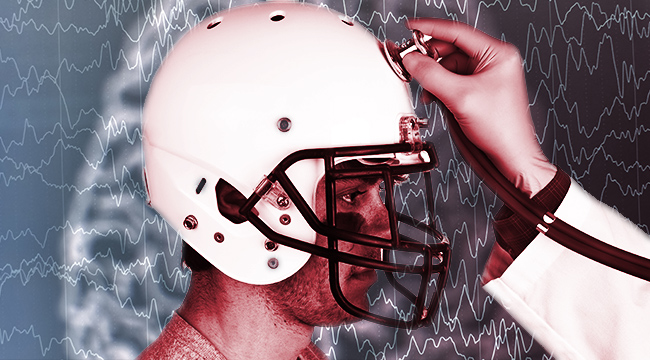
Chronic traumatic encephalopathy, or CTE, is a major point of contention among sports fans. And a new CTE study, covered by The New York Times, is only going to add fuel to the fire. Contact sports like football, it turns out, may be more dangerous to your brain the longer you play, but that’s only the beginning. The study opens the door to a much broader, and more worrying, set of questions about CTE. In short, the more shots you take to the head, and the more repeated they are, the more danger you’re in. But does that just apply to football players? Or does it apply to all of us across the long term? In other words, are we all potentially at risk?
It’s important, first, to understand what CTE is. CTE is a neurodegenerative disease which belongs to the same family as Alzheimer’s. Unlike Alzheimer’s, CTE results from repeated trauma to the brain, which causes the organ to lose mass while building up an abnormal protein called tau. As mass declines, it begins to affect behavior — emotional outbursts, memory loss, poor judgement — before leading to more serious problems, including dementia. The brain, for lack of a better description, decays inside the skull.
CTE isn’t just caused by massive, head-shaking hits, either. Players who experience head collisions that don’t cause concussions aren’t immune. Even when not concussive, head injuries add up over time and contribute to CTE. Worse, CTE is impossible to diagnose without an autopsy, meaning there’s no treatment. And that’s why this study isn’t just important, it’s potentially life-saving.
CTE expert Dr. Ann McKee looked at 202 brains of football players, including 111 brains from former NFL players, over the course of the study. Of the NFL players, 110 showed signs of CTE. When McKee looked at all the brains in the study, which included Canadian Football League players, semi-pro players, and college and high school players. 87% of the brains showed at least a mild case of CTE:
Among 202 deceased former football players (median age at death, 66 years [interquartile range, 47-76 years]), CTE was neuropathologically diagnosed in 177 players (87%; median age at death, 67 years [interquartile range, 52-77 years]; mean years of football participation, 15.1 [SD, 5.2]), including 0 of 2 pre–high school, 3 of 14 high school (21%), 48 of 53 college (91%), 9 of 14 semiprofessional (64%), 7 of 8 Canadian Football League (88%), and 110 of 111 National Football League (99%) players. Neuropathological severity of CTE was distributed across the highest level of play, with all 3 former high school players having mild pathology and the majority of former college (27 [56%]), semiprofessional (5 [56%]), and professional (101 [86%]) players having severe pathology.
In other words, the longer one played football or engaged in any activity in which resulted in repeated head injury (even mild injury), the more advanced CTE was found. This stood out in particular in the tragic case of 27-year-old NFL player Tyler Sash, who died from an overdose of painkillers:
Despite Sash’s young age, his family requested that his brain be examined for C.T.E. because he was showing uncharacteristic signs of confusion, memory loss and fits of anger. Their suspicions were confirmed. Dr. McKee said at the time that: “Even though he was only 27, he played 16 years of football, and we’re finding over and over that it’s the duration of exposure to football that gives you a high risk for C.T.E. Certainly, 16 years is a high exposure.”
This raises some serious and troubling questions about contact sports — not just football, but everything from football to hockey to MMA. McKee has found CTE in even junior hockey players. Since the symptoms only manifest years after the player leaves the field or the ring, it seems, essentially, a crapshoot. Players are, in slow motion, gambling with their lives every time they suit up. There’s no way to know whether they have CTE, whether they may develop it, and how advanced their cases might be until they’re dead, and even then, only if their brains are donated to science. The early signs of CTE, like memory loss, attention deficits, and headaches, don’t offer any clear direction for players, coaches, or for that matter the rest of us. Even Sash’s parents only had a suspicion CTE was involved in his emotional problems later in life, something McKee’s study confirmed for them.

For those not involved in contact sports, the main question is “How much does this apply to us?” Football players, it’s true, experience more head trauma than most people But while it takes more than one knock to cause CTE, Americans suffer head injury constantly. In fact, in an average year, 1.3 million Americans will experience a type of traumatic brain injury where they’re simply treated and released. We fall off ladders, we get in car wrecks, we dump our bikes, we trip over the dog. For that matter, how many minor head injuries do we collect over a lifetime that we get annoyed at and promptly forget? In other words, we may not be slamming into defensive linemen day in and day out, but over our lifetimes, we collect plenty of knocks on the head, concussions, and other brain injuries. Do those cause the same problems? Do the seemingly minor head injuries we collect over the course of a lifetime add up to serious medical problems as we age? In short, is CTE a common ailment or just a risk for those who put their heads in the line of fire?
We simply don’t know. There are vast gaps in our knowledge, not just of CTE but in the brain itself. In fact, the more we learn about the brain, the more it highlights how ignorant we are of our most important organ. Furthermore, how would we have known to check until now? CTE used to be known as being “punch-drunk,” as boxers showed signs of neurological degeneration that was written off as a disease limited to pugilists for decades. The idea that even football players could be affected only started being considered roughly 15 years ago, when Dr. Bennet Omalu performed an autopsy on former Pittsburgh Steeler Mike Webster. And it’s not like info is easy to come by. Relatively few of us donate our bodies to science, let alone give doctors permission to take slices of our brains out. Part of the reason the study is limited largely to football players is that they have the most visible, obvious signs, but what about the more subtle ones?
CTE still comes with question marks. Not everyone who gets repeatedly hit in the head seems to be affected, for example, which raises the question of whether it’s a matter of skull density or simply that some brains are tougher than others. What this underscores, though, is that we’re just beginning to understand the brain and how the hits we take affect it over the course of a lifetime. The organ we need and value most, the seat of our consciousness, is a thing we’re only beginning to fully value. As we come into that consciousness, protecting our heads will be a priority of the highest order.






